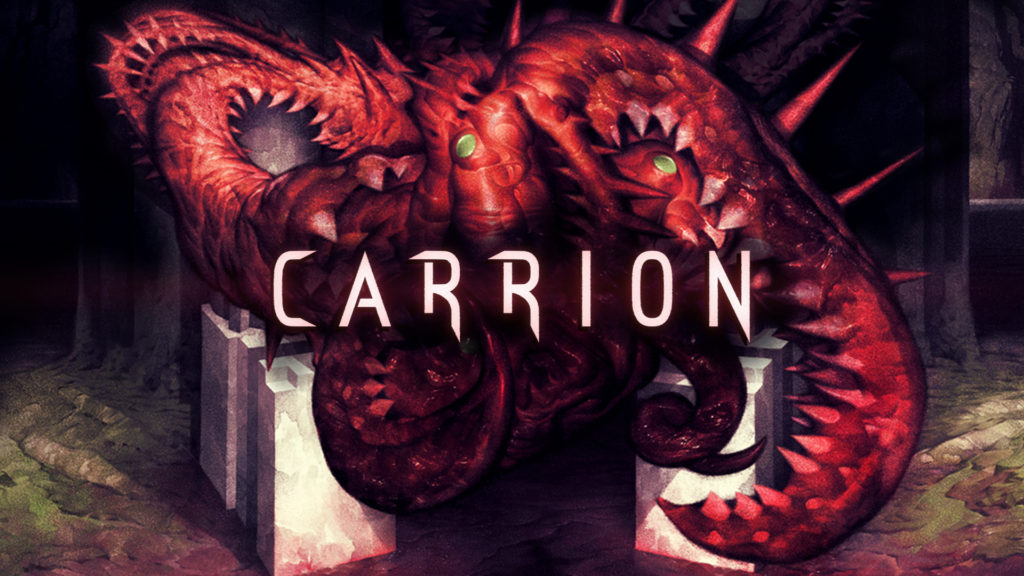
Complete lack of erotic elements aside, the title above is pretty much what Carrion, the new game from Phobia Game Studio and publisher Devolver Digital, is all about. You may have seen some screens of Carrion already on the Devolver Digital event a couple weeks ago, or even played the demo when it was live on Steam. If so, you probably have a good idea what’s going on here, but for the uninitiated, Carrion is a ‘horror game in reverse’.
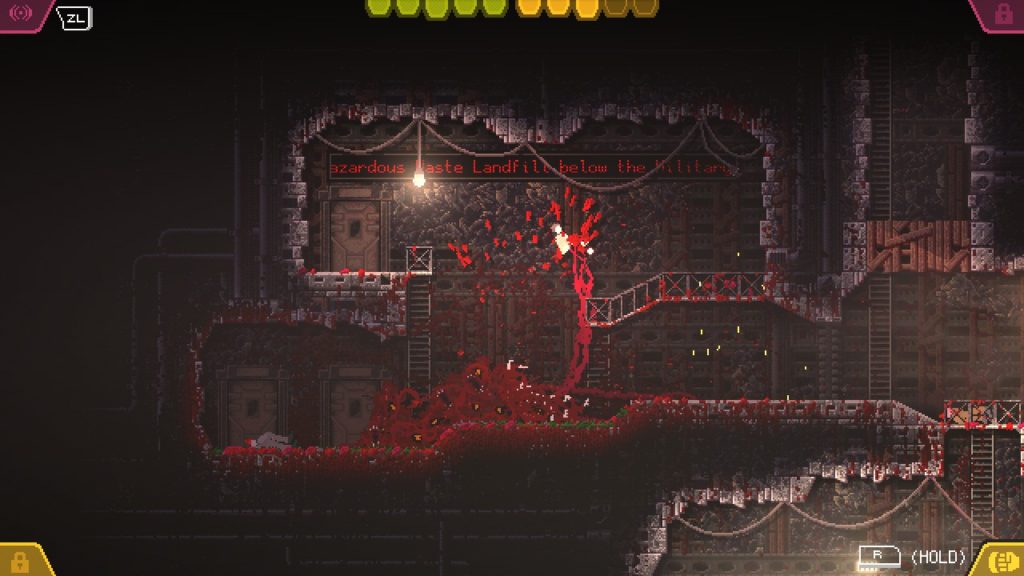
In it, you play a monster of unknown origin, all tentacles and teeth much like something from John Carpenter’s The Thing. Unlike the monster in The Thing however, this creature is fast and agile, and it rips around the facility at breakneck speed, killing humans left and right. The entire facility that you’re trapped inside is a massive maze with routes and locked doors that you have to find your way around and vicious security systems that attack you at every opportunity. This is essentially a Metroidvania where you play the monster and its fun as all get out. There are a few things that set Carrion apart from other games in the genre though, aside from the obvious.
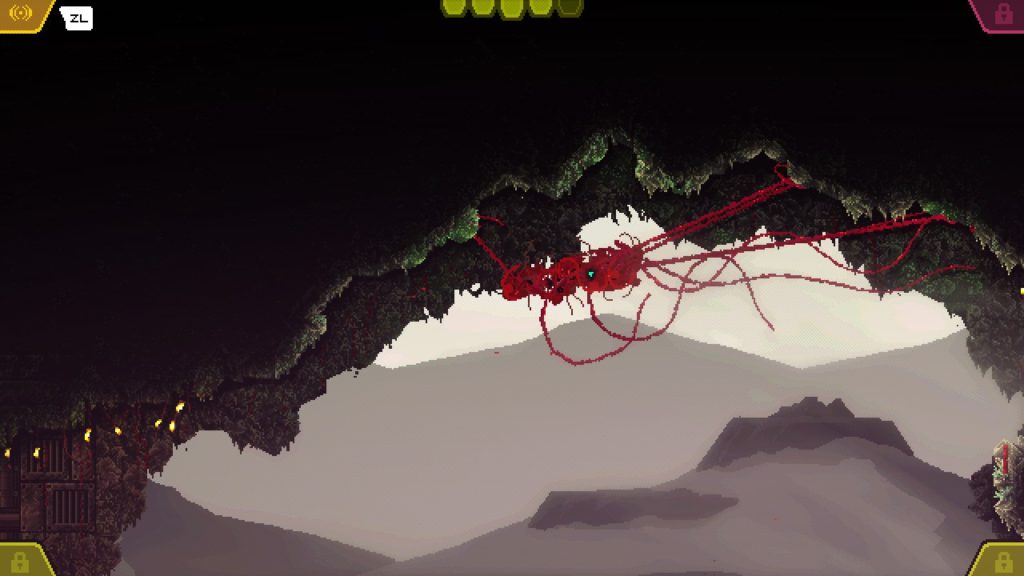
The first thing you’ll notice when playing Carrion is that there’s no storyline. No plot. No introduction. There’s not even an intro screen with a title. You simply start the game and away you go. There’s no tutorial on how to play other than quick written explanations of your buttons. This is as pure of a gaming experience as you can get and highly reminiscent of 90s games on the SNES or Genesis. There’s not a lick of help to be had anywhere, and it’s both refreshing and surprising. The next thing you’ll notice once you’ve been playing for a while is that there’s no map.
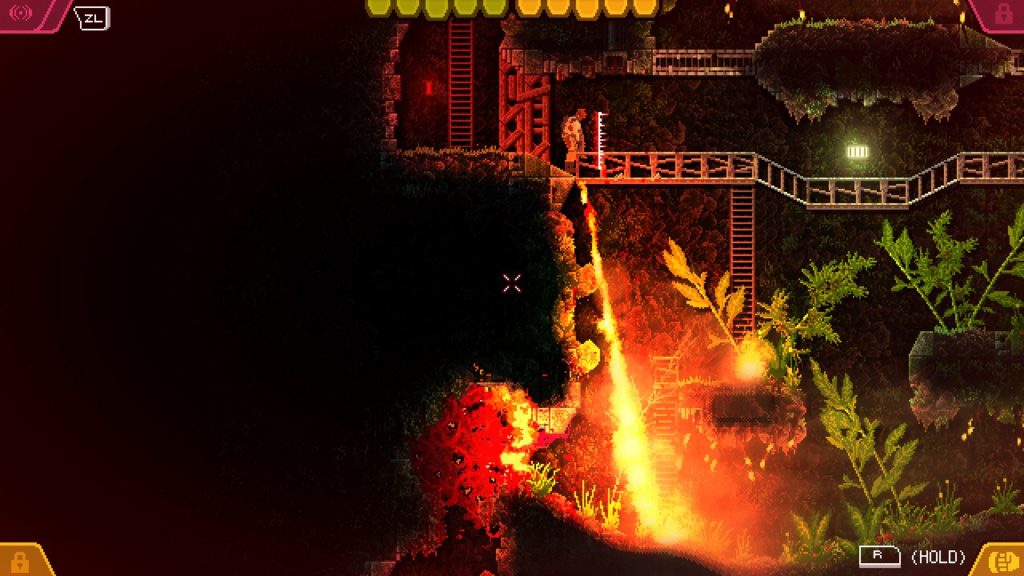
You can’t simply figure out how to get there from here on a menu system like Hollow Knight or Axiom Verge. You have to remember which of the remarkably similar tunnels and passageways connect to each other and not get lost. Good luck with that, by the way. Carrion is so maze-like and disorienting that it’s particularly challenging to find your way around. As the creature, you move incredibly quickly and fluidly too, so you may hurtle past something so quickly that you don’t realize you can climb into it or go down a tunnel. This one is going to be a nightmare for modern gamers who are used to being led by the hand every step of the way and constantly checking their locations on a HUD or map. Easily a third of the time I clocked on Carrion was simply slithering around areas looking for whatever small item I missed that opened up access to a new area. And it’s easy to accidentally wind your way into a section you already completed and then completely lose track of where that section was as well, even if you know where to go next.
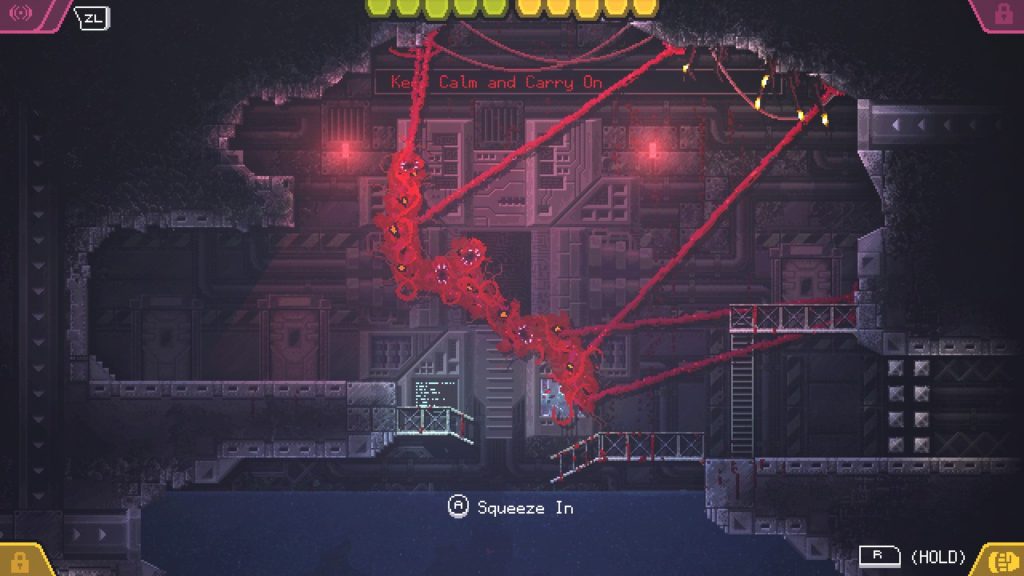
If you’re paying attention, Carrion is fairly linear though. As long as you don’t get turned around or go down the wrong passage, it’s easy to make your way from place to place as they unlock. It’s setting down the game after saving and then coming back to it that makes reorienting yourself incredibly challenging. The creature methodically makes its way through the base’s many areas, slaughtering humans and consuming them for health. You infect the base with your biomass and create save points at the same time. These points are both respawn points and healing areas for when you’ve slaughtered most of the humans in your path. In point of fact, by the end of the game, I was leaving unarmed humans alive, just because the base felt too quiet and I liked the screaming and whimpering every time I entered the room. It was all a bit too much like the club scene in Virtuosity and I felt more than a little like SID 6.7, but it’s incredibly fun as well.
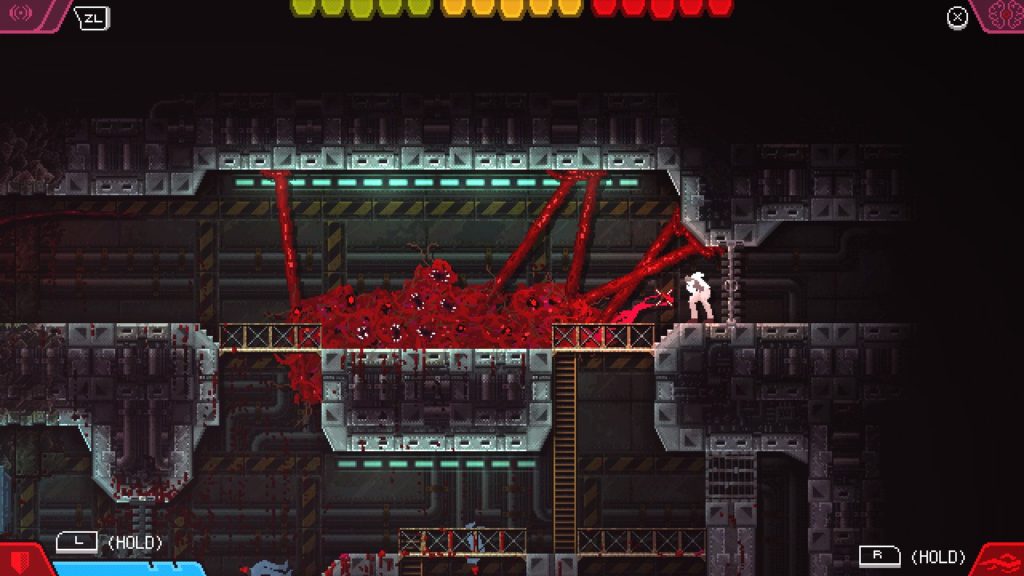
As you progress you’ll unlock new areas, and the game updates you on the infection levels in the base and what’s unlocked via clever digital notice boards in each area. They also indicate whether you’ve unlocked the optional upgrades in each area (9 in all) that are both harder to find and difficult to master, almost like puzzle challenge rooms. Carrion can easily be completed without these options though, so never fear if they’re just a pain or you forgot how to get to them, which will definitely happen.
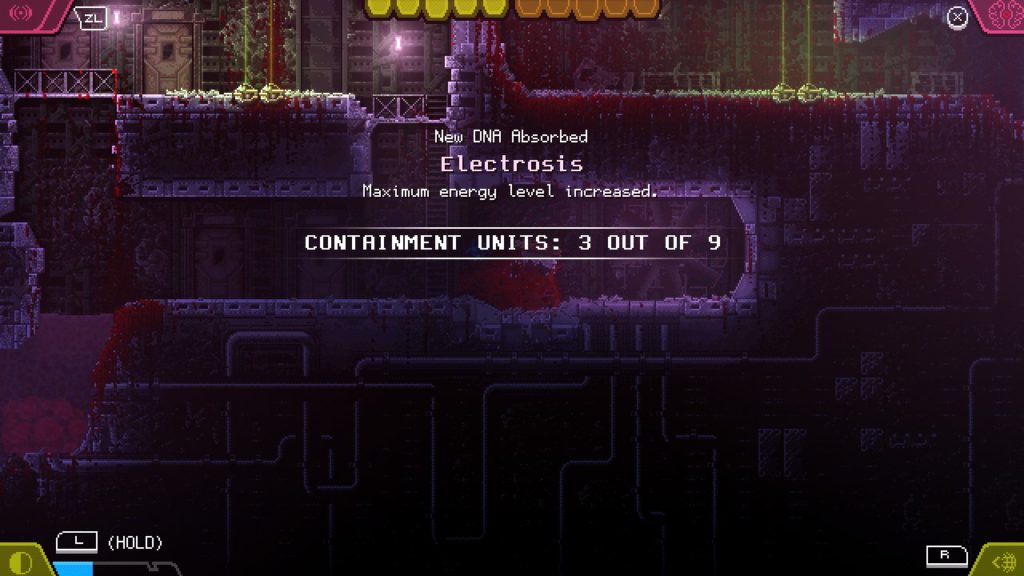
The mechanics of Carrion are excellent. As the creature, initially you can grab with the R button and the right stick and drag humans into your gaping maw, consuming them. You can also roar, scaring them into running away and detecting save points and unactivated save points. You can grab switches, open doors, and rip apart grates easily with your tentacles and even use them as weapons, whipping an enemy with them before they open fire on you. As you mutate by absorbing biomass from canisters, your body gets bigger, eventually gaining three health bars with 5 segments each. You also gain a variety of mutated powers, including more powerful attacks, parasitic infections, and even the ability to turn into a mass of writhing worms. Different upgrades only work at certain biomass sizes, so eventually you’ll literally have to leave some of yourself behind to progress, thereby also dropping your life meter and putting yourself at higher risk of extermination by the filthy humans. Some of the upgrades are unique and interesting, so I definitely don’t want to spoil them here. The game plays incredibly smoothly on the Switch and is just as good in portable mode as it is in docked mode, though you will inevitably lose out on some of the fine detail because the pixels are so small undocked.
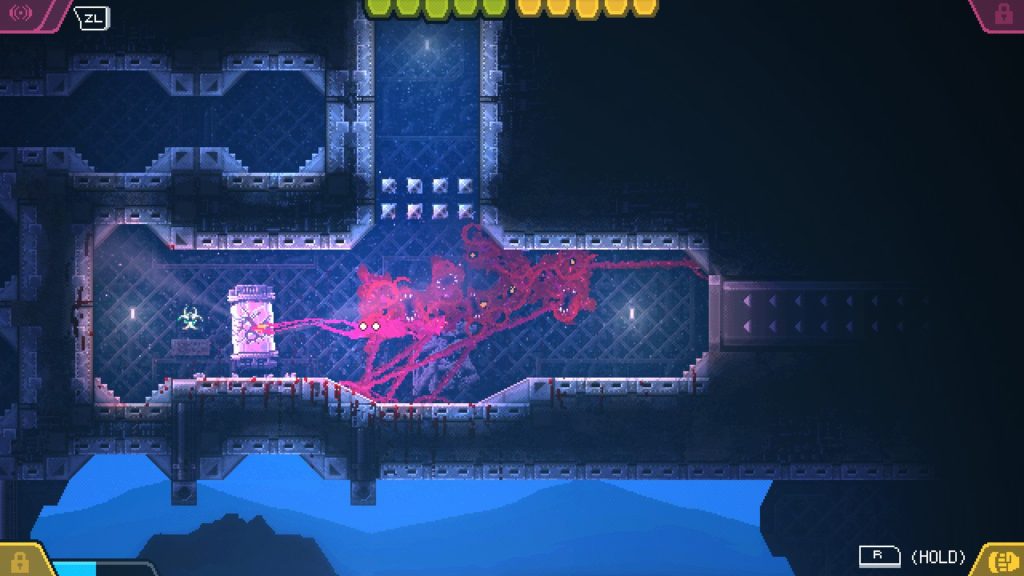
Visually, Carrion is simply stunning. It masquerades as an old pixel art game, but no vintage system could handle the graphics output here, with fluid, organic motion by the creature, rapid movement on any surface available, and not a lick of slowdown on the Switch. Blood is literally everywhere, and some rooms end up pretty much entirely red after you’re done with those pesky human opponents. This is not a game for the squeamish, even though it’s entirely done in pixel art. The soundtrack matches the game well, reminiscent of an 80s horror movie as you creep up and attack the humans, shredding their fragile, squishy bodies and consuming the juicy inner bits. And outer bits. And even their clothes and shoes apparently. You’re not the pickiest alien monster. Regardless, it’s an outstanding score, brought down only by the dramatic music that sometimes pops up while you’re searching vainly for the next area to attack and there’s not a soul in sight. Curse those alien eyes that can’t read maps!
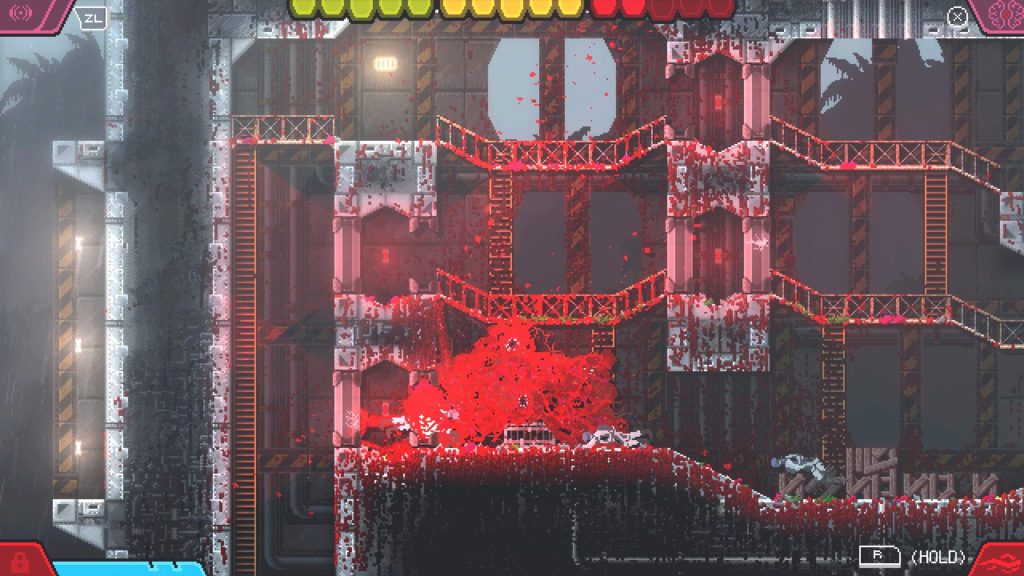
Aside from the lack of a map function or any real directions, there are only a few weak points to Carrion. The complete lack of story aside from a few flashback moments was a bit of a letdown, although the flashbacks themselves were pretty cool. You’ll definitely want to know more and be left wanting. But that’s also the beauty of this style of story. Back in older horror movies and stories from the 80s, not everything got explained and that’s a good thing. It makes you take a game or story for what it is and ignores any potential plot holes, sealing them by not exploring them. There is also no menu of any kind, which means you can’t look at your character’s powers, abilities, or anything else. The biggest challenge though (pun intended) is the size of your creature.
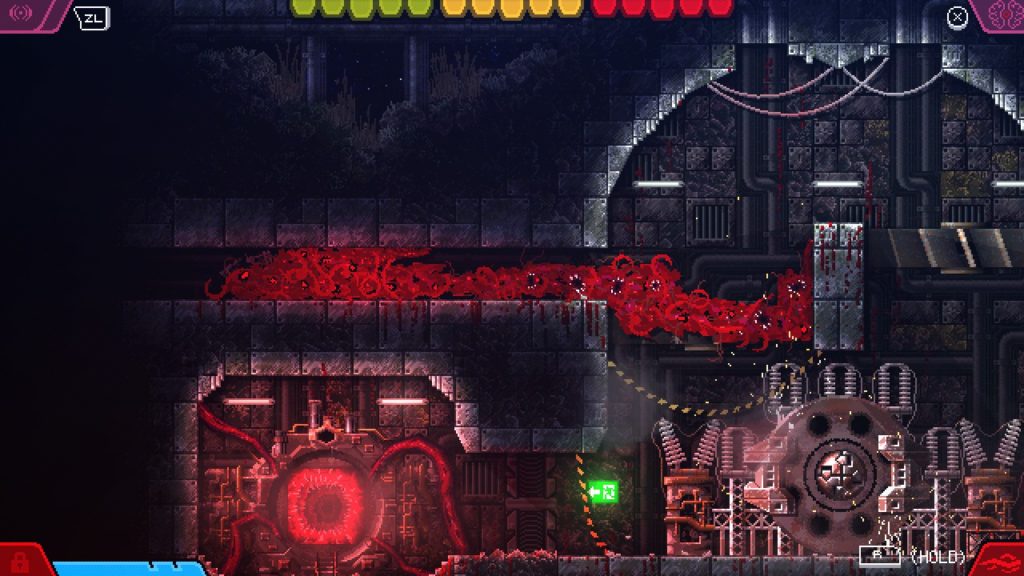
Once you get the third life bar, you are simply enormous. And enormous creatures are harder to move around. Unfortunately, that actually hinders you in the later levels of Carrion, where the creature will get stuck oozing around corners and through passages. It’s hard to turn and go down the correct path out of multiples, and preserving that life bar to fight enemies towards the end is key, so you’re kind of screwed either way. Drop off some biomass to become more maneuverable and end up too weak to take on a room full of troops and military machinery. It’s a bit of a balancing act, and especially with the smaller creature controlling so well, the larger one is more than a bit irritating. It’s all done incredibly well, don’t get me wrong, it’s just that when you’re a giant blob full of mouths, it’s hard to tell which part of the blob is the front, especially in a small area.
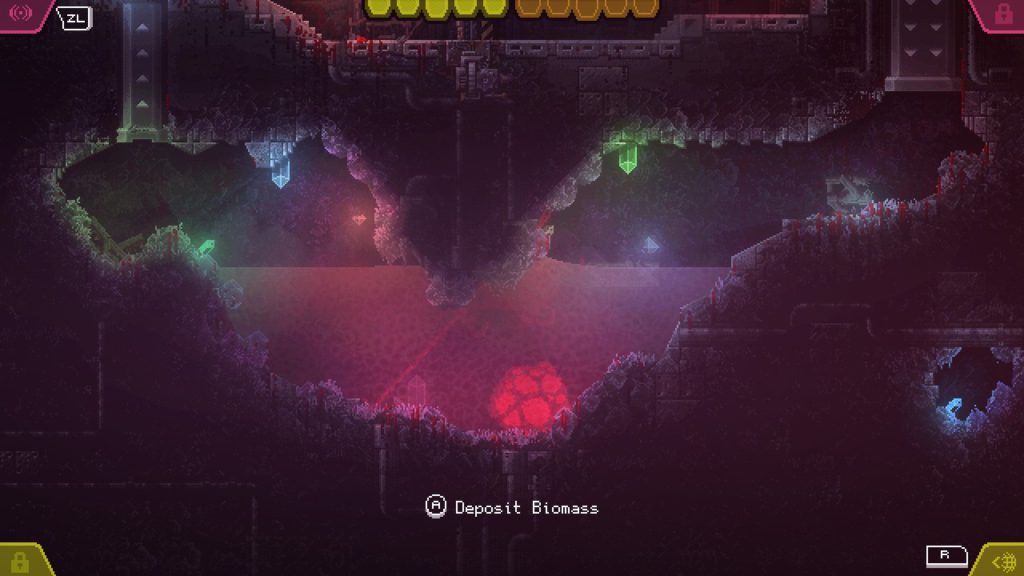
If you have a good digital direction sense and are good at simple puzzle solving, Carrion should take you no more than about 5 or 6 hours. If you get lost along the way a few times, as many people are likely to do, you can still finish in a few days of casual play. It’s not the longest game out there, but if it were any longer, it would likely feel like it was dragging on. Instead, Phobia Game Studio has opted for a more concise, more intense experience and it works pretty much all around. Controlling the creature is simply fantastic, the humans are everywhere and fun to interact with, and the puzzles are challenging but not impossibly hard. It’s honestly hard to overstate how incredibly fluid and intuitive gameplay is. This is simply an incredibly well-crafted horror game with not a glitch to be seen anywhere. Carrion is, ironically, a breath of fresh air in an increasingly stale genre. At $20, it’s certainly worth the price of admission. It’s a fantastic game from start to finish and will leave you, well, um, thirsting to kill more humans!
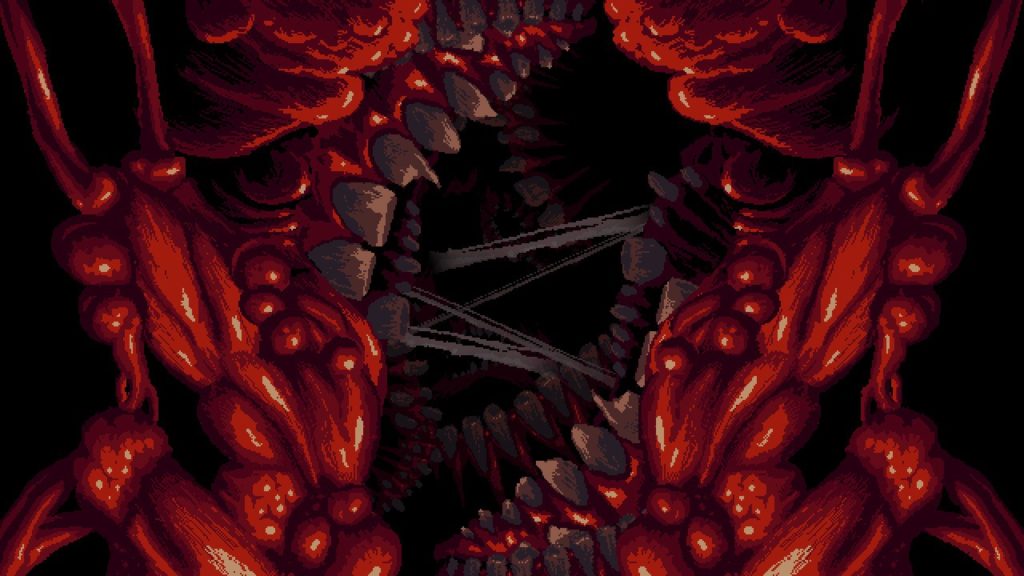
This review is based on a digital copy of Carrion provided by the publisher. It was played on a Nintendo Switch in both docked and undocked modes and was excellent in both! Carrion is also available for the Xbox One and PC on both Steam and GOG. Limited physical releases of Carrion are also being released by both Limited Run Games and Special Reserve Games. All screenshots are of actual gameplay. If you’re not aware, the title of this review is a quote from Futurama, made by Bender ‘Bending’ Rodriguez, the hard-drinking, human hating robot. If you didn’t know that, you should probably watch more Futurama once you’re done playing Carrion!

